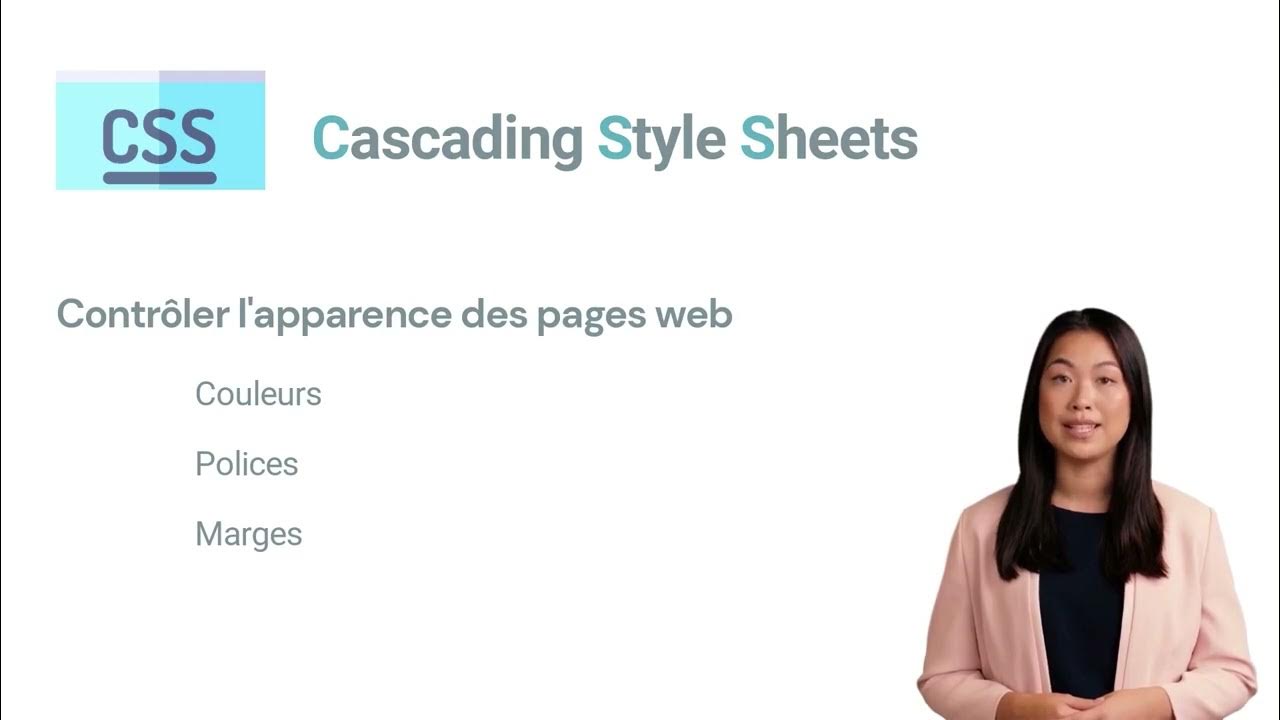HTML, CSS, JavaScript Explained [in 4 minutes for beginners]
Summary
TLDRDans cette vidéo, on explore les trois langages fondamentaux du développement web : HTML, CSS et JavaScript, surnommés 'Los Tres Amigos'. HTML, le constructeur, définit le contenu de la page, CSS, l'artiste, gère le style et la mise en page, tandis que JavaScript, le magicien, ajoute l'interactivité. Ces trois langages, bien que distincts, travaillent ensemble pour créer des sites web dynamiques. La vidéo explique également leur évolution au fil du temps et comment ils sont traduits par les navigateurs pour offrir une expérience utilisateur fluide sur le web.
Takeaways
- 😀 HTML, CSS et JavaScript sont les trois langages fondamentaux du développement web.
- 😀 HTML est le 'Constructeur', responsable du contenu de la page, comme le texte, les images et les liens.
- 😀 CSS est l' 'Artiste', qui ajoute du style aux pages web, comme la couleur, la police et la disposition du contenu.
- 😀 JavaScript est le 'Magicien', utilisé pour des fonctionnalités dynamiques comme les popups et l'autocomplétion.
- 😀 HTML, CSS et JavaScript fonctionnent ensemble pour créer des sites web complets et fonctionnels.
- 😀 Un site web codé uniquement en HTML serait très basique et ne serait pas visuellement attrayant.
- 😀 CSS ne peut fonctionner sans HTML, car il n'y a rien à styliser sans contenu HTML.
- 😀 JavaScript permet d'ajouter des interactions et des animations sur les sites web.
- 😀 Le développement web front-end concerne tout ce que vous voyez sur une page, contrairement au back-end qui gère la logique et le fonctionnement d'une application.
- 😀 Les navigateurs web comme Chrome et Firefox traduisent HTML, CSS et JavaScript en une page web visuelle, mais il peut y avoir des différences d'affichage entre eux.
- 😀 HTML, CSS et JavaScript évoluent constamment, et la norme actuelle est HTML5, qui est supervisée par une organisation dédiée à leur développement.
Q & A
Quels sont les trois langages de base utilisés sur toutes les pages web ?
-Les trois langages de base sont HTML, CSS et JavaScript.
Pourquoi le script appelle-t-il HTML, CSS et JavaScript 'Les Trois Amigos' ?
-Parce que ces trois langages travaillent ensemble pour construire, styliser et rendre interactif un site web, chacun ayant un rôle complémentaire.
Quel est le rôle principal de HTML dans le développement web ?
-HTML, ou Hypertext Markup Language, sert à créer la structure et le contenu d'une page web, comme le texte, les images et les liens.
Comment CSS influence-t-il l'apparence d'un site web ?
-CSS, ou Cascading Style Sheets, ajoute du style à la page web en définissant les couleurs, les polices, la disposition et le positionnement du contenu.
Quel est le rôle de JavaScript sur un site web ?
-JavaScript rend le site web interactif en permettant des animations, des popups, des autocomplétions et d'autres fonctionnalités dynamiques.
Qu'est-ce que le développement front-end et comment se distingue-t-il du back-end ?
-Le développement front-end correspond à tout ce que l'utilisateur voit et avec quoi il interagit sur une page web. Le back-end, en revanche, gère la logique et le fonctionnement interne d'une application web.
Pourquoi les sites web peuvent-ils apparaître différemment selon le navigateur utilisé ?
-Parce que chaque navigateur interprète légèrement différemment le HTML, CSS et JavaScript, ce qui peut modifier l'apparence et le comportement d'une page web.
Comment ces langages ont-ils évolué au fil du temps ?
-HTML a d'abord contrôlé la présentation, CSS a pris en charge la majorité du style, et JavaScript est passé de simples popups à des animations et interactions avancées. Aujourd'hui, HTML5 définit les standards actuels.
Qu'est-ce que HTML5 et quel est son rôle ?
-HTML5 est la version standard actuelle d'HTML, définissant les meilleures pratiques et les règles pour le développement front-end moderne.
Pourquoi ne peut-on pas utiliser CSS ou JavaScript sans HTML ?
-Parce que CSS et JavaScript nécessitent du contenu HTML sur lequel agir. CSS ne peut pas styliser ce qui n'existe pas, et JavaScript ne peut pas rendre interactif un contenu inexistant.
Quelle analogie le script utilise-t-il pour comparer les langages d'un site web à un pays ?
-Le script compare HTML, CSS et JavaScript aux trois langues officielles de la Belgique (français, néerlandais, allemand), illustrant comment plusieurs langues peuvent coexister et travailler ensemble.
Outlines

Cette section est réservée aux utilisateurs payants. Améliorez votre compte pour accéder à cette section.
Améliorer maintenantMindmap

Cette section est réservée aux utilisateurs payants. Améliorez votre compte pour accéder à cette section.
Améliorer maintenantKeywords

Cette section est réservée aux utilisateurs payants. Améliorez votre compte pour accéder à cette section.
Améliorer maintenantHighlights

Cette section est réservée aux utilisateurs payants. Améliorez votre compte pour accéder à cette section.
Améliorer maintenantTranscripts

Cette section est réservée aux utilisateurs payants. Améliorez votre compte pour accéder à cette section.
Améliorer maintenant5.0 / 5 (0 votes)






